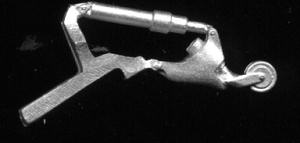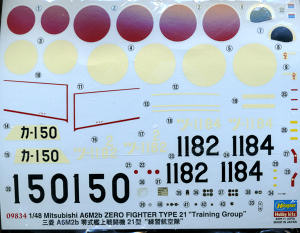
|
KIT # |
09834 |
|
PRICE: |
$44.00 SRP |
|
DECALS: |
Three options |
|
REVIEWER: |
Scott Van Aken |
|
NOTES: |
2008 boxing |

|
HISTORY |
|
THE KIT |
 Hasegawa pretty well has the field for 1/48 Zeros,
though Tamiya is making inroads. They
box almost every known variant, including some rather rare types, like
the A6M8. All use the same basic fuselage, cockpit and tail section as
that was unchanged. They simply change the wings and the engine to match
whatever version is being done.
Hasegawa pretty well has the field for 1/48 Zeros,
though Tamiya is making inroads. They
box almost every known variant, including some rather rare types, like
the A6M8. All use the same basic fuselage, cockpit and tail section as
that was unchanged. They simply change the wings and the engine to match
whatever version is being done.
This results in several inserts and add on bits that vary
from one aircraft type to another. It also means that the main molds do a
lot of service. My kit was boxed in 2008, and are in superb shape, which tells
me that perhaps they cut another set of molds or have at least taken good
care of what they have. As one expects
from Hasegawa, the level of detail is quite good. There are lots of
aftermarket bits for the Zero should you wish that additional level of
detail, but most of us will be quite satisfied with what comes in the
box. I especially like that there are instrument decals provided that fit
perfectly over the various panels. Saves my
 having to paint these things
and looks a ton better than I could ever do myself.
having to paint these things
and looks a ton better than I could ever do myself.
Options for the kit are quite limited. You basically have
the choice of leaving the canopy open or closed. As this is a training
version, the choice to cut off the lower rear portion of the fuselage is
there so that the included cast metal tail gear assembly can
 be
installed. This was done to ease maintenance and make it easier for those
doing target tug duty to attach the target. The tail hook was removed from
these and a plate put over the well. These planes often did not carry radios
and in some cases had the antenna mast removed.
be
installed. This was done to ease maintenance and make it easier for those
doing target tug duty to attach the target. The tail hook was removed from
these and a plate put over the well. These planes often did not carry radios
and in some cases had the antenna mast removed.
Instructions are excellent and give all colors in Gunze references. There are options for three aircraft: Two are from the Tsukuba Flying Group in 1944. One still has the rear fuselage left intact for those squeamish about cutting on the kit. Both are in Nakajima Green over Orange-Yellow with black cowlings. The third option is for a target tug with the Kasumigaura Naval Flying Group. This one is in overall Orange-Yellow Grey/Green with a black cowling and a white tail band with the aircraft identifier in it. All of these planes have large under wing numbers, typical of trainers and other second line aircraft.
|
CONCLUSIONS |
Overall, it is an excellent model. They say that more Zeros are built than any other aircraft model and I can see where that could well be the case. I've built several of these Hasegawa Zeros in the past and I don't see any reason why I won't do more in the future.
August 2012
Kit courtesy of me and the Great Models end of days sale.
If you would like your product reviewed fairly and fairly quickly, please contact the editor or see other details in the Note to Contributors.